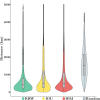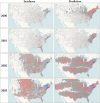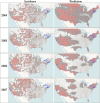This is a preprint.
Modeling the velocity of evolving lineages and predicting dispersal patterns
- PMID: 38895258
- PMCID: PMC11185746
- DOI: 10.1101/2024.06.06.597755
Modeling the velocity of evolving lineages and predicting dispersal patterns
Update in
-
Modeling the velocity of evolving lineages and predicting dispersal patterns.Proc Natl Acad Sci U S A. 2024 Nov 19;121(47):e2411582121. doi: 10.1073/pnas.2411582121. Epub 2024 Nov 15. Proc Natl Acad Sci U S A. 2024. PMID: 39546571 Free PMC article.
Abstract
Accurate estimation of the dispersal velocity or speed of evolving organisms is no mean feat. In fact, existing probabilistic models in phylogeography or spatial population genetics generally do not provide an adequate framework to define velocity in a relevant manner. For instance, the very concept of instantaneous speed simply does not exist under one of the most popular approaches that models the evolution of spatial coordinates as Brownian trajectories running along a phylogeny (Lemey et al., 2010). Here, we introduce a new family of models - the so-called "Phylogenetic Integrated Velocity" (PIV) models - that use Gaussian processes to explicitly model the velocity of evolving lineages instead of focusing on the fluctuation of spatial coordinates over time. We describe the properties of these models and show an increased accuracy of velocity estimates compared to previous approaches. Analyses of West Nile virus data in the U.S.A. indicate that PIV models provide sensible predictions of the dispersal of evolving pathogens at a one-year time horizon. These results demonstrate the feasibility and relevance of predictive phylogeography in monitoring epidemics in time and space.
Keywords: BEAST; PhyREX; West Nile virus; integrated velocity models; phylogeography.
Figures





Similar articles
-
Modeling the velocity of evolving lineages and predicting dispersal patterns.Proc Natl Acad Sci U S A. 2024 Nov 19;121(47):e2411582121. doi: 10.1073/pnas.2411582121. Epub 2024 Nov 15. Proc Natl Acad Sci U S A. 2024. PMID: 39546571 Free PMC article.
-
Inferring language dispersal patterns with velocity field estimation.Nat Commun. 2024 Jan 2;15(1):190. doi: 10.1038/s41467-023-44430-5. Nat Commun. 2024. PMID: 38167834 Free PMC article.
-
Evolutionary dynamics of lineage 2 West Nile virus in Europe, 2004-2018: Phylogeny, selection pressure and phylogeography.Mol Phylogenet Evol. 2019 Dec;141:106617. doi: 10.1016/j.ympev.2019.106617. Epub 2019 Sep 12. Mol Phylogenet Evol. 2019. PMID: 31521822
-
Accommodating sampling location uncertainty in continuous phylogeography.Virus Evol. 2022 May 18;8(1):veac041. doi: 10.1093/ve/veac041. eCollection 2022. Virus Evol. 2022. PMID: 35795297 Free PMC article. Review.
-
Biogeography and speciation of terrestrial fauna in the south-western Australian biodiversity hotspot.Biol Rev Camb Philos Soc. 2015 Aug;90(3):762-93. doi: 10.1111/brv.12132. Epub 2014 Aug 15. Biol Rev Camb Philos Soc. 2015. PMID: 25125282 Review.
Cited by
-
Detection of divergent Orthohantavirus tulaense provides insight into wide host range and viral evolutionary patterns.Npj Viruses. 2024 Dec 4;2(1):62. doi: 10.1038/s44298-024-00072-y. Npj Viruses. 2024. PMID: 40295885 Free PMC article.
References
-
- Baele G., Dellicour S., Suchard M., Lemey P., and Vrancken B. 2018. Recent advances in computational phylodynamics. Current Opinion in Virology, 31: 24–32. - PubMed
-
- Barndorff-Nielsen O. and Shephard N. 2003. Integrated OU processes and non-Gaussian OU-based stochastic volatility models. Scandinavian Journal of Statistics, 30: 277–295.
-
- Barton N., Etheridge A., and Véber A. 2010. A new model for evolution in a spatial continuum. Electronic Journal of Probability, 15: 162–216.
-
- Barton N., Etheridge A., and Véber A. 2013. Modelling evolution in a spatial continuum. Journal of Statistical Mechanics: Theory and Experiment, 2013: P01002.
Publication types
Grants and funding
LinkOut - more resources
Full Text Sources
